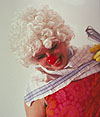|
 |
|
|
|
 |
|
to index
|
BEHIND A PAINTED SMILE
The Work of Vibeke Sjøvoll
By Francis Mc Kee
|
|
|
Vibeke Sjøvoll's work is peopled by exiles from the carnival. A sweet, touchingly naive dancer in a tutu, a couple of tetchy, thin-skinned clowns, even an enigmatic diver beached on a British main street.
Sjøvoll explores the psyche of entertainers and the psychology of entertainment in her video and photographic works. In Professional, for instance, a young dancer spins endlessly on point, looped almost cruelly into a dizzying execution of her chosen art. The power and fascination of the video resides in the gap between the ideal - a spinning ballerina, and the real - a valiant girl teetering on the edge of a fall. That Platonic ideal of the spinning ballerina can, perhaps, only be satisfied if the audience is placed far enough away from the dancer, so that the flaws and human distractions of sweat, breath and anxious eyes are out of range. In Professional, Vibeke Sjøvoll deliberately brings us too close to the subject and all of the flaws are revealed.
Likewise, in Make Me Laugh, she presents us with a series of slides in which one clown attempts to make another burst into laughter. The use of slides to document these attempts immediately warns us that all is not what it might be. The silence, broken only by the clack of changing slides, dampens our preconceived notions of humour and noisy, clown inspired fun. As the silence deepens, we can only watch helplessly as one clown fails to make the other break into a smile. When finally, the clowns do laugh the tension is just broken for a moment before the next slide returns us to their humourless interplay.
Just as in Professional, Sjøvoll takes us too close to the subject in her work and reveals its flaws. Make Me Laugh exposes the brutal, aggressive edge that lurks beneath all humour, subverting the cosy, family image of the circus clown. The lack of fun evident between the couple who are professionally trained to make people laugh also emphasises the difficulty of any human communication. Sjøvoll quietly underpins this sense of tragedy by her use of slides raher than video in this piece. The still photographic image carries with it a sense of documenting an event which has occurred in the past and is now ended. Video, on the other hand, implies a sense of being and continuity through its ceaselessly moving image. The mortality inherent in the photograph frames Sjøvoll's work, creating a silent commentary on human interaction that reaches beyond the simpler theme of clowning.
Much of the ability of these works to transcend their subject and achieve a deeper resonance stems from Sjøvoll's skill in working with her models. In Professional, a great deal of the video's power lies in the character of the young dancer Vibeke Sjøvoll chose to perform the piece. Her naive sincerity, her ability to laugh at herself and her touching determination are so clearly real and could not have been recreated convincingly by an actress. More to the point, these qualities were accidental to the original work and emerged as the video was being made. What Sjøvoll has done is recognise these qualities, allow them to reveal themselves and the incorporate them into the finished work. Likewise, in Make Me Laugh, the darker edge of the two clowns' personalities is recognised and revealed through the progress of the piece.
The process of making each of these works and the relationship's created by Sjøvoll are all documented within the finished artwork. As viewers we are aware of Sjøvoll's presence behind the camera and can sense her empathy with the subject of each work. This becomes most apparent in the surreal short film, Hundred Miles, in which a scuba diver is seen walking along a busy street in Glasgow, while Vibeke gently sings the song 'Hundred Miles' on the soundtrack. At one telling point, the camera stops viewing the diver from a distance and we are suddenly looking at the world through the diver's goggles. It is that particular moment which Sjøvoll seeks in each of her works, where it is possible to make that great leap of communication and see through another's eyes, even if just for an instant.
Extending this idea, it is possible to see each of these pieces she has created as meditations on the nature of art itself. Her dancer and clowns have a sterotypical set of gestures and costumes which they ultimately have to transcend in the creation of their art. Their human flaws and the limits of their skills (think of Sjøvoll's dancer failing to juggle) serve to highlight their real achievements when they succeed in their chosen act. These works trace the boundaries of art and its limitations while always reminding us of the possibility that, at any given moment, those boundaries could be breached and something new might be created.

See Vibeke Sjøvolls art project
MAKE ME LAUGH |
|
 |
|
|
|
|
|
|
|
|
|
|

